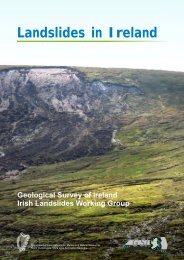Kilworth Water Supply Scheme - Geological Survey of Ireland
Kilworth Water Supply Scheme - Geological Survey of Ireland
Kilworth Water Supply Scheme - Geological Survey of Ireland
Create successful ePaper yourself
Turn your PDF publications into a flip-book with our unique Google optimized e-Paper software.
4.3 AssessmentAnalysis <strong>of</strong> the data utilised field studies and previously collected data to delineate protectionzones around the source.5 Topography, Surface Hydrology and Land UseThe borehole is located in the Funshion River valley, on the south side <strong>of</strong> the river. The areaon both sides <strong>of</strong> the river is quite flat. To the south <strong>of</strong> the borehole the land rises steeply to aheight <strong>of</strong> about 50 m, where there is a broad ridge before dropping steeply to the BlackwaterRiver Valley. To the north <strong>of</strong> the Funshion the land rises steeply to well over 200 m in the<strong>Kilworth</strong> Mountains.The Funshion, Blackwater and Araglin Rivers are the main water features in the area. Thearea between Fermoy and Downing Bridge is free draining with no drains or surface streams.The Funshion flows to the southeast 30 m north <strong>of</strong> the borehole and joins the Blackwaterabout 2 km downstream.The land is primarily used for agricultural purposes, mainly pasture. Two farms occur within1 km <strong>of</strong> the source, one <strong>of</strong> which is the Teagasc Moorepark Research Farm.A primary road passes about 20 m east <strong>of</strong> the borehole (N8, Cork-Dublin). Fermoy town is2.5 km south <strong>of</strong> the source.6 Geology6.1 IntroductionThis section briefly describes the relevant characteristics <strong>of</strong> the geological materials thatunderlie the borehole. It provides a framework for the assessment <strong>of</strong> groundwater flow andsource protection zones that will follow in later sections.Bedrock information was taken from a desk-based survey <strong>of</strong> available data, which comprisedthe following:• Bedrock Geology 1:100,000 Map Series, Sheet 22, East Cork-<strong>Water</strong>ford. <strong>Geological</strong><strong>Survey</strong> <strong>of</strong> <strong>Ireland</strong>. (Sleeman, A.G., et al, 1995).• The Carboniferous Geology <strong>of</strong> the Fermoy and Mitchelstown Synclines, Southern <strong>Ireland</strong>.(Shearley, E.P., 1988, Unpublished PhD thesis, University <strong>of</strong> Dublin.)• Information from geological mapping in the nineteenth century (on record at the GSI).Subsoils information was gathered from a drilling programme that was undertaken by GSIpersonnel to investigate the subsoils <strong>of</strong> the area.6.2 Bedrock GeologyThe rocks are the result <strong>of</strong> sediments deposited during Carboniferous times (over 300 millionyears ago). The area is underlain entirely by the Waulsortian Limestone Formation. This rockunit is described as being a pale grey massive LIMESTONE.The rocks have been deformed during a ‘mountain building event’, known as the VariscanOrogeny and were compressed from north and south to produce an east-west trend. The2
















